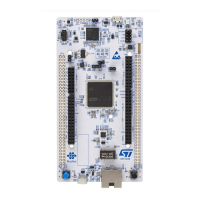Hardware layout and configuration UM2407
28/48 UM2407 Rev 1
Hardware connection required for USART bootloader:
The STM32H7x3 embeds USART bootloader. To use the USART bootloader (USART1),
hardware modifications are required on the NUCLEO board. Flying wires have to be
connected between PD8/PD9 (USART3 available on SB19/SB12) and PB10/PB11
(USART1 available on CN15).
6.6.6 USB OTG FS
The STM32H7 Nucleo-144 board supports USB OTG FS communication via a USB Micro-
AB connector (CN13) and USB power switch (U18) connected to V
BUS
.
Warning: USB Micro–AB connector (CN13) cannot power the Nucleo-
144 board. To avoid damaging the STM32H7, it is mandatory
to power the Nucleo-144 before connecting a USB cable on
CN13. Otherwise there is a risk of current injection on
STM32H7 I/Os.
A green LED LD8 lights in one of these cases:
• Power switch (U12) is ON and STM32H7 Nucleo-144 board works as a USB host
• V
BUS
is powered by another USB host when the STM32H7 Nucleo-144 board works as
a USB device.
The red LED LD7 lights if overcurrent occurs when +5 V is enabled on V
BUS
in USB host
mode.
Note: 1.It is recommended to power Nucleo-144 board by an external power supply when using
USB OTG or host function.
2.SB76 must be ON when using USB OTG FS.
Table 11. LPUART1 connection
Pin
name
Function Virtual COM port Arduino D0 and D1 ST morpho connection
PB6 LPUART1 TX
SB9 ON
SB8 and SB18 OFF
SB8 ON
SB9 and SB18 OFF
SB9 OFF and SB18 OFF
PB7 LPUART1 RX
SB34 ON
SB12 and SB68 OFF
SB68 ON
SB34 and SB66 OFF
SB12 OFF and SB34
OFF
Table 12. USB pin configuration
Pin
name
Function
Configuration
when using USB
connector
Configuration
when using ST
morpho connector
Remark
PA8 USB SOF - - Test point TP4
PA9 USB V
BUS
SB23 ON SB23 OFF -
PA10 USB ID SB24 ON SB24 OFF -
PA11 USB DM SB21 ON SB21 OFF -

